
Search
The Renewable Energy site for Do-It-Yourselfers
Grey Water Heat
Recovery from Exposed Drain Pipes
|
I've been thinking a bit more
about simple ways to recover some of the heat that goes down the drain
when you take a shower.
Think about the shower
process from an energy point of view:
- Water comes in from the
street at about 50F.
- Your hot water heater
heats the water up to about 110F shower temperature. This uses about
10,000 BTU (3 KWH) for a typical 10 minute shower with a lowish flow
shower head.
- The shower water flows
over you in the shower, and goes down the drain at about 100F,
taking with it about 85% of the energy you just spent heating it up
-- what a waste!
Multiply this by however many
showers your family takes in a day. For a family of 4, just the
wasted can amount to about 300 KWH a month -- and about 500 lbs of CO2
emissions a month. |
|
So, there must be some good way to
make use of this energy we are sending down the drain?
Here are some existing methods that
people have used or thought about:
- There are some
commercial solutions that transfer some of the heat in the outgoing
shower water into the incoming cold shower water to preheat it.
There are some thoughts on
DIY schemes to do the same...
- Of course, if you take tub
baths, a simple way to recover the heat in the water is just to let it cool
off in the tub before you pull the drain plug. This will recover most
of the heat in the bath water down to room temp.
- I guess you might think about a
way to run the shower drain into the bathtub to accomplish the same thing?
While it seems like these methods
should get a lot more attention than they do, none of them seems to be taking
off in popularity.
Another Approach to Recovering
Shower Water Heat
This page considers a method that is
not as effective as the ones just above, but that is simpler to put accomplish,
and appears to have some potential (at least in heating climates) for useful
energy saving.
The idea is to recover the heat in
the draining shower water for space heating.
This is not as good as preheating the
incoming shower water (discussed above) because 1) during the summer you
don't need the heat, so its a seasonal recovery, and 2) you can only recover the
heat from the drain temperature of about 100F down to about 70F room
temperature.
Anyway, the method I was thinking
about is to arrange the shower drain plumbing in such as way that the water
stays in the drain plumbing until it cools off. The heat it loses while
cooling off becomes space heating to the house, and reduces furnace fuel.
One thought on doing this would be to
add enough large diameter drain pipe below the existing shower trap to hold
about 1 showers worth of water (say 15 gallons). The extra drain
pipe would be arranged so that it fills up completely, and then as more water
comes in, the water in the added drain piping "overflows" into the regular drain
piping and out to the sewer or septic tank as usual.
If 4 inch PVC drain pipe were used to
store one showers worth of water, it would take about 23 ft of added pipe to
store 15 gallons.
I would want to arrange the plumbing
so that the extra 4 inch PVC can be easily bypassed in the summer when you don't
want to recover the heat.
The heat recovery potential is about:
Water used per 10 min shower =
(1.8 gpm)(10 min) = 18 gallons = 150 lbs
Heat recovered = (150 lbs) (100F
- 70F) (1 BTU/lb-F) = 4500 BTU per shower -- about 1.3 KWH per shower
This might be increased somewhat by
insulating the shower better, so there is less
cool off of the shower water from the shower head to the shower drain...
This might get the savings up to about 1.7 KWH per shower -- which is a bit more
than half the energy that went into heating the shower water -- not so bad?
I am guessing that this scheme may
not meet plumbing codes(?). But, the added "storage pipe" would be beyond
the regular shower trap, and would be vented by the regular vent system.
So, it seems to me that the potential for health or odor problems is minimal?
I'd like to hear anyone's thoughts on
this --
gary... Is it worth giving this a try?
A nice side issue on this is that it
can be used in addition to solar water heating -- basically you can get (with a
good system) nearly 100% of your water heated by solar, and then recover 50% or
so of that heat again for space heating -- what a deal!
A Rough Test of the Drain Water Heat
Recovery Potential
This is a quick test to assess the
potential of drain pipe recovery.
In my house, there is a conditioned
crawl space under the main bedroom/shower area. The drain pipe from this
bathroom goes all the way across the crawl space and exits the other side.
I thought I might get an idea of the potential for recovering heat from drain
water by just measuring how much heat this existing drain pipe transfers to the
crawl space now.
The plot below shows the result.
From a heat recovery point of view,
it appears that at any given time during the shower, the water temperature drops
about 9 to 10F from the start of the 22 ft pipe to the end.
So, the heat recovered to the crawl
space is about:
Water used per 10 min shower =
(1.8 gpm)(10 min) = 18 gallons = 150 lbs
Heat recovered = (150 lbs) (10F)
(1 BTU/lb-F) = 1500 BTU per shower -- about 0.5 KWH
The logic here is that the heat that
is coming out of the water (as calculated from its temperature drop) is going
into the the crawl space. Since ours is a conditioned crawl space
(unvented and insulated), this counts as space heating energy.
These numbers seem worthwhile, and
this is just from a pipe that happens to run through the crawl space with no
attempt to retain the water long enough to lose all its heat. It should be
possible to do much better if the plumbing is rearranged as discussed above to
retain the grey water until the heat is all transferred.
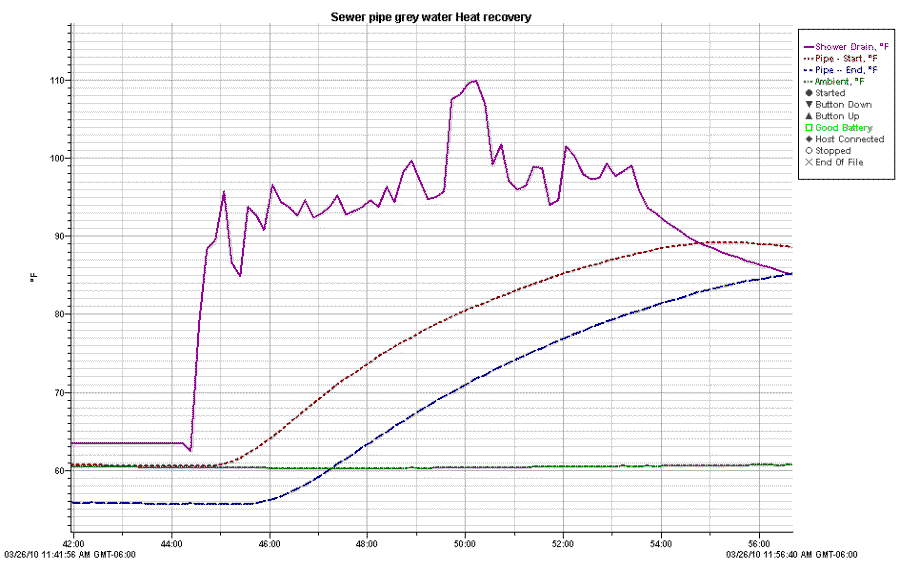
Plot shows the drop in temperature
within the 22 ft long drain pipe.
Purple -- Temperature of water going
down shower drain
Red dashed -- Temperature of outside
of drain pipe at start of 22 ft drain pipe run
Blue dashed -- Temperature of outside
of drain pipe at end of 22 ft drain pipe run
Green dotted -- Ambient crawl space
temperature
All in degrees F.
During the shower period, the water
in the drain pipe warms up about 9 to 10F over the 22 ft of exposed pipe.
The purple line is the temp of the
water going down the shower drain. The brief increase in this temperature
at 50 minutes is caused by moving the sensor briefly from the drain area up to
the shower head -- so, you can see that the temperature of the water drops about
10F from the shower head to the drain.
The reason that the pipe temps don't
follow the purple shower drain temps more closely is that the drain pipe sensors
are mounted on the outside of the pipe (with insulation over them), and there is
some lag due to the sensor reaction time and the mass of the pipe.
I did not thing it was a good idea to
drill holes in the sewer pipe to put the sensors right in the flow :)
Click on pictures for full size
|
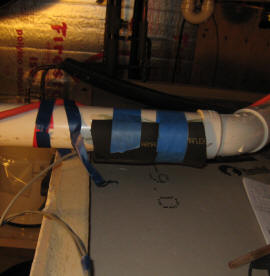
Temperature sensor at start of 22 ft pipe
The sensor is under the taped on pipe
insulation. |
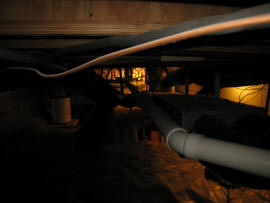
View down the long section of 3 inch
PVC drain pipe that crosses the
crawl space. |
|
|
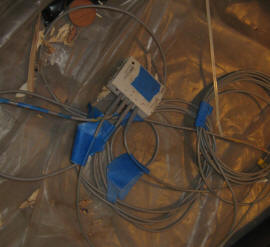
The Onset Computer 4 channel logger. |
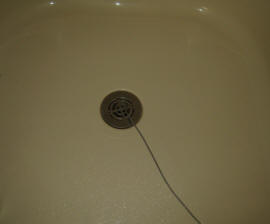
Sensor in the shower drain. |
|
Mercifully, no pictures were taken of
during the actual shower event.
Gary March 26, 2010

